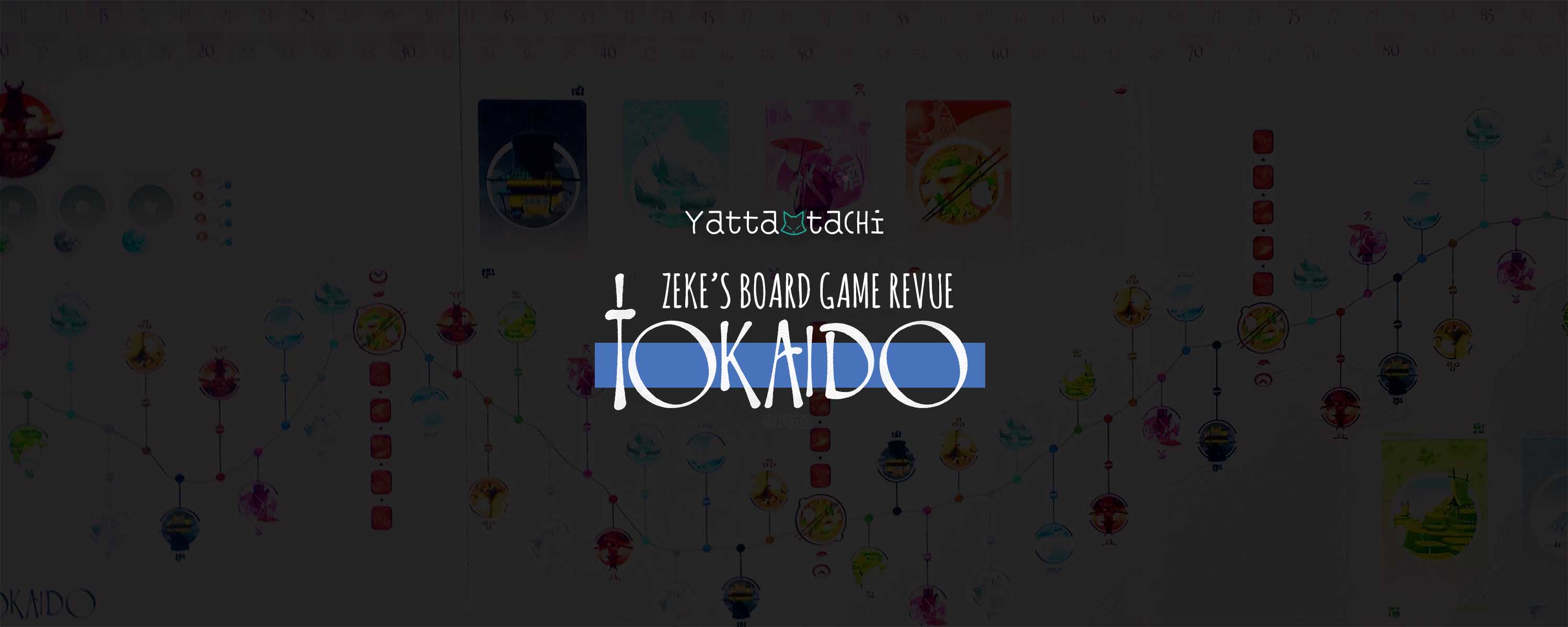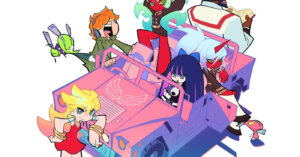Hello, loyal readers! It is I, Zeke, and I am back with a new game! This time we’re doing something a bit different. Instead of looking at a classic Japanese game, I’m going to examine something more modern. This game isn’t from Japan, per say, but it is heavily influenced by it in terms of art and setting. This week I bring the game about traveling the East Sea Road, Tokaido!
History & Game Type
The game doesn’t have a long history, being only a few years old, but the trip it is based on does. Tokaido (東海道 Toukaidou, “east sea road”) was a trading route between Edo (modern-day Tokyo) and Kyoto during the Edo period, an era lasting from 1603-1868 in Japan. The road was not only a major trade route but also featured heavily in art and literature at the time due to the scenic nature of the route.
In Tokaido, you play the role of a traveler on a journey along this route. You stop at inns, eat yummy meals, purchase souvenirs, meet interesting people, visit hot springs, and of course take in the beautiful scenery. The game is less about winning and more about the experience. Sure, there are still points, and there is a winner at the end, but when the objective of the game is described as “try to make this journey as rich an experience as possible,” you know you aren’t in for a normal board game.
Speaking of board games, this is our first game to be featured that follows the format of what we normally call a “board game.” Each player is represented by pieces on the board and those pieces advance to some goal, interacting with each square they land on in a particular way. Movement is not luck-based (no dice in this game) but the cards are randomized as are your starting positions at the first inn.
Equipment
Tokaido has a variety of pieces, but once you learn what they all are, it’s pretty easy to keep track of them.
The Game Board

First up is the board. Besides the art (which I think is quite pretty), you may notice the long line with all the dots along it. Well, on the left we have Kyoto and the to the far right we have Edo. Along the way are many stops. The ones with a bowl of food and five red dots are the inns along the way, for example.
Each colored dot corresponds to a stack of cards associated with that stop. We have black Village stops, yellow Farm stops (which don’t have a card), the three Panorama stops (green, white, and blue), teal Hot Spring stops, gold Temple stops (which also don’t have cards) and finally pink Encounter stops. Up at the top of the board is the score counter. The score is tracked during gameplay: simply move your counter as you gain points. Over to the upper left is the Temple section, where you may offer donations in order to score more points for the end. The other sections on the board are where the stacks of cards are placed during game play.
Traveler Cards

These cards are the various characters you can play as on your journey. Each character has a name, a starting amount of gold, a special ability that is fully explained in the rules, and a little hole where you can put a token representing the color of your piece on the board.
Character Pieces
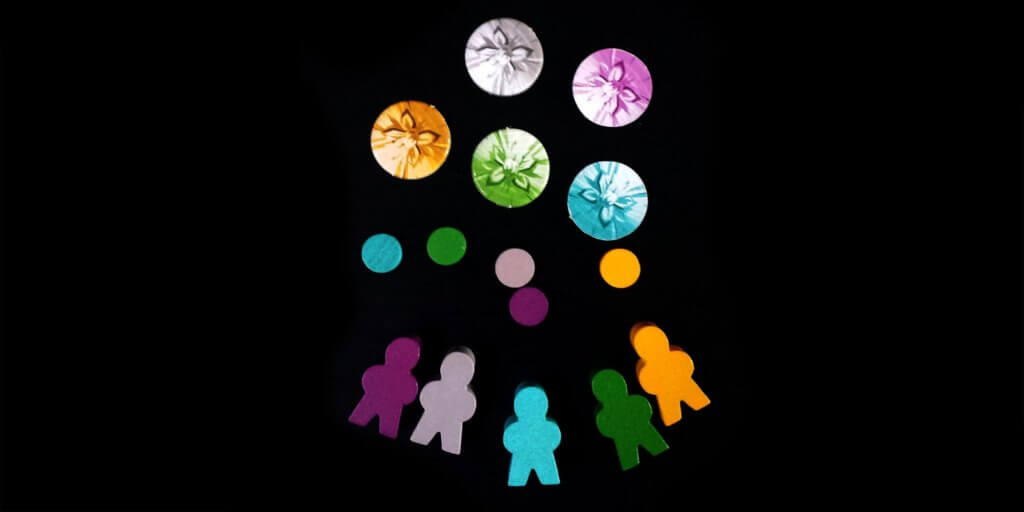
These pieces represent our chosen character on the board. The large circles go into the character cards to help keep track of everyone’s color. The small circles go on the scoreboard to keep track of points. The little people-shaped pieces are the things you move along the road to represent your progress.
Stop Cards
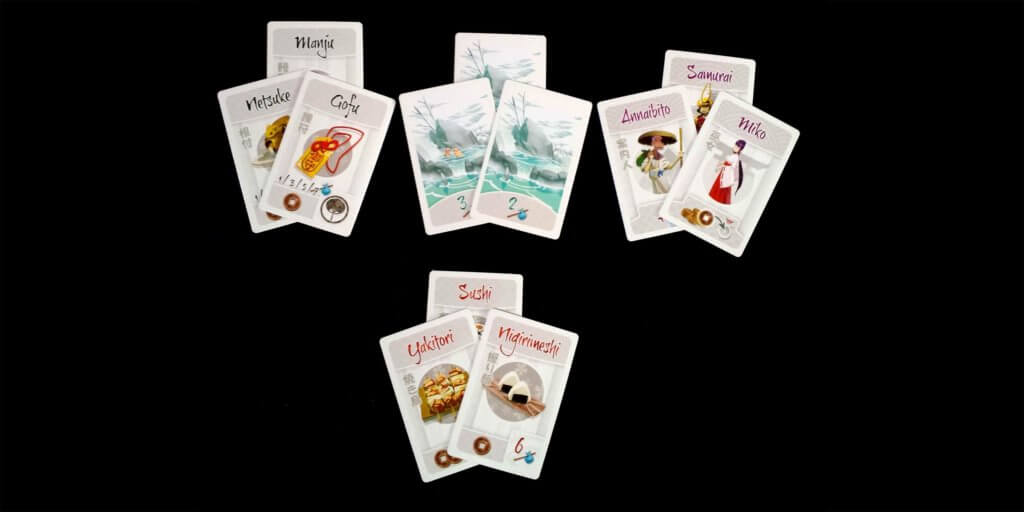
These are the various cards for your stops along the route. First, we have Souvenirs. You buy these at villages for the number of coins shown on the card. The point value depends on how many cards you have in the set. Sets of souvenirs are made up of 4 types: small objects, clothing, art, and food and drinks.
Second are the Hot Spring cards. You simply score the points shown and put the card to the side. Easy enough.
Third are the Encounter cards. These have various effects ranging from getting a free souvenir, to a free donation to the temple.
Last are the Meal cards. These are only used at inns. The first player to arrive at the inn gets their choice of a variety of meals, paying the price shown and gaining the points for the meal. The players who arrive later choose from the remaining meal cards.
Panorama Cards
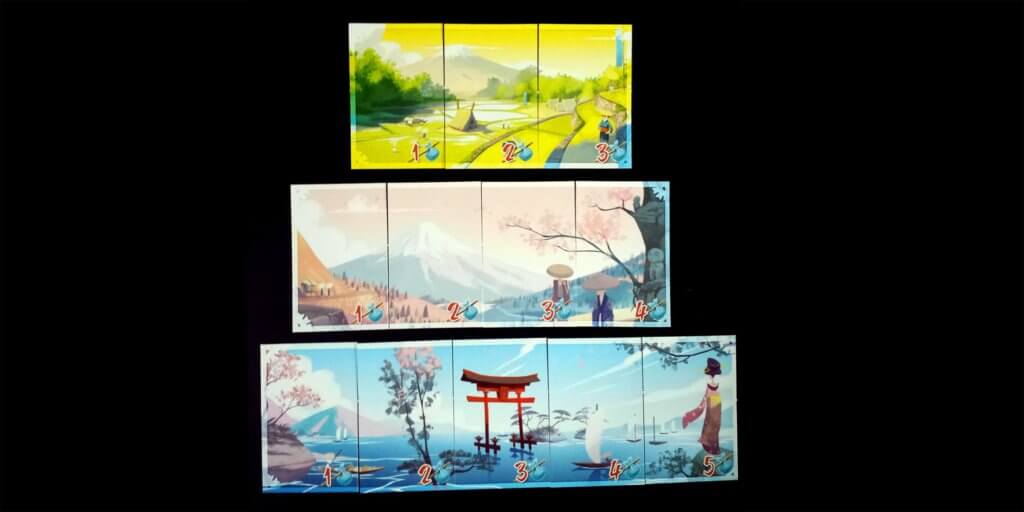
The last of the in-play cards are the Panorama cards. These represent the sights you will see while traveling along the road. For each Panorama space you land on, you may take a Panorama card of the same color. The first to complete a set gets bonus points.
Achievement Cards
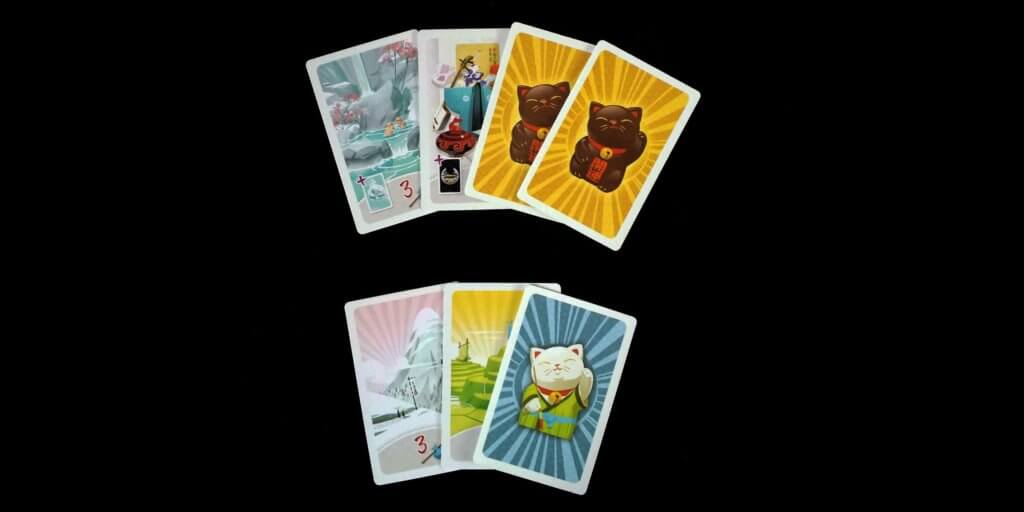
These cards are only used for scoring at the end of the game. They are awarded to travelers who perform special feats during their journey. I talked about the bonus points for being the first to complete a panorama; those are awarded via an Achievement card. There is a card for buying the most expensive food, one for scoring the most points from hot spring visits, one for having the most encounters, and finally one for the most souvenirs.
Now that we know about all the pieces, let’s take a peek at how the game is played!
Set up and Gameplay
Tokaido is fairly easy to set up. First, all the cards are sorted, shuffled, and placed onto their respective places on the board. Next, each player selects a color and a character. Then, they place their colored circle into the character card and the small circle on the scoring section of the board. The final part of setting up is placing the character pieces randomly in a line at the starting inn. Now play can begin!
Playing Tokaido is about as easy as setting it up. On the first turn, the player last in line moves their piece. Movement during gameplay is what makes this very different from other board games. Instead of dice, or some predetermined amount you can move, you place your piece wherever you want, up to and including the next inn. Now, there is a catch. You cannot move backward. This means if you pass something, you miss out. So that means you stop everywhere, right? Well now, hold on. Except for inns, and a couple of special spaces with multiple dots, two players cannot land on the same space. This means you can be blocked from stopping somewhere. But, in turn, you can block a stop you know your opponents want. Movement in this way is largely how you interact with other players.
After a player has moved, the player who is now last in line at the inn moves, and so on until all have left the inn. Now, when everyone has left the inn, turn order changes. Whoever is the furthest behind moves until they are no longer last. Yes, this means you could hop to several spaces in a row. If you are in a stop that allows multiple people, the one off the road is considered further along, breaking ties between other players.
As you land on each space, you draw the card associated with that color. Each stack of cards has different effects, but all of them help you gather points and enrich your journey. All the cards a player draws are kept in front of them to represent their experience. These also act as a double-check for points at the end.
Stops Along the Road
The Village stop allows you to purchase souvenirs from your travels. These range from kama (tops) to sake to shamisen (a Japanese stringed instrument). When a player arrives at this stop, they draw three cards and purchase whichever one they want. They immediately score points according to how complete their set is. The unbought cards are placed on the bottom of the pile.
The Farm stop earns a player three coins.
Panorama stops give a player one card they do not have from the color-appropriate set. If a player completes a set, they can no longer stop at that panorama color.
Hot Spring locations give a Hot Spring card, which the player immediately gains points for and adds to their collection.
The Temple spaces allow players to donate money in exchange for points. The player with the most donations at the end gets bonus points, so be generous!
The last normal stop is the Encounter. When a player lands here, they draw the top card and apply whatever its effect may be. The Samurai card gives you points, the Guide gives you a free panorama, and so on. There are a number of interesting people you can meet on the road!
That last stop of each leg of Tokaido is an Inn. The first player to the inn draws Meal cards equal to the number of players plus one. They look at these cards in secret and may choose one for themselves. If they choose to purchase a meal, they pay for it and add it to their collection. The other cards are placed face down for the rest of the travelers. The second person to arrive looks through the cards, may choose and buy one, and then puts the rest back. This continues until all the players have arrived and been offered meals.
From the Second Inn to the Journey’s Conclusion
Now that all players have arrived, the person in last (the last to arrive) moves their piece first, just like the first inn. And on goes the adventure! Play continues this way, stopping, gathering cards and points, and reaching inns, until all the players have reached Edo (or Kyoto, depending on which way you decided to travel). Then the game ends and achievement cards are handed out. If you kept track of the points during gameplay, the scoreboard should now reflect the winner. But, if you feel something is missing, no worries. All your points are also tracked in your cards. The person with the most points is said to have had the most fulfilling journey and is declared the winner!
Wrap up
So there you have it, an intro into the zen journey of Tokaido. I’ve played the game with a couple friends, and it is a relaxing trip. There is a calming quality to slowly walking along the road and experiencing all the sights and adventures. Competition can be fun, but it can also be fun to sip some tea with your gaming buddies and just enjoy the ride.
What do you think? Are you intrigued by the idea of a game with a more casual, stop-to-smell-the-flowers approach? Or do you crave action and throwing dice? Any games you want to see me look at? Please let us know in the comments below!
Until next time, keep playing your favorite games, and never forget the best journeys are shared with friends!
Interested in owning the game? You can purchase Tokaido on Amazon.
For more about the historical road, visit Wikipedia here: Tokaido (road)
For more details about the game, visit the official website here: Tokaido – Funforge
Big thank you to our supporters
From their continous support, we are able to pay our team for their time and hard work on the site.
We have a Thank-You page dedicated to those who help us continue the work that we’ve been doing.
See our thank you page